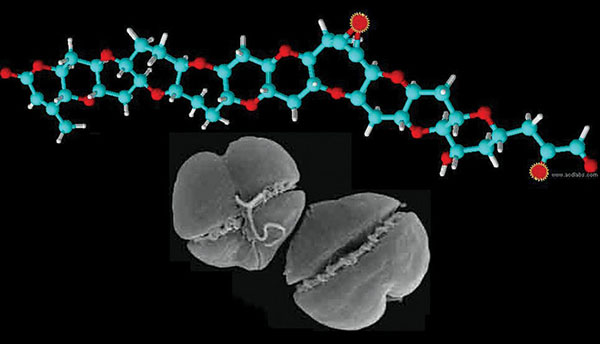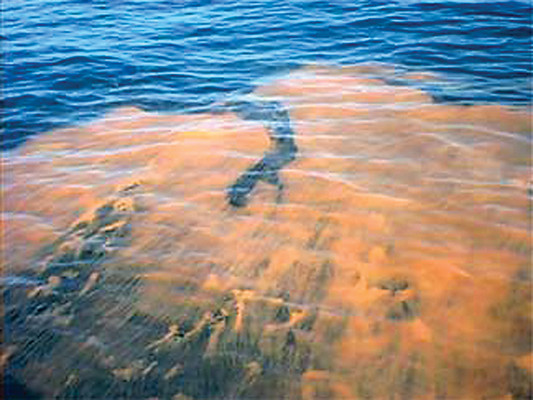
by Cassandra Willyard Thursday, January 5, 2012

A scanning electron microscope image of _Karenia brevis_, the algae responsible for producing red tides in the Gulf of Mexico, and a computer model of brevetoxin that highlights the two reactive sites that bind DNA. Courtesy of John Ramsdell, photo by Karen Steidinger

Algae blooms called red tides lend the water a reddish tint. NOAA
In the Gulf of Mexico lurk menacing masses of single-celled organisms known as red tides. Scientists have long known that the potent toxin they produce can kill fish and birds, wreak havoc on the human nervous system and cause wheezing, sneezing and asthma flare-ups. But new research suggests that it can also damage DNA, which could lead to more subtle, longer-term health consequences.
Red tides, or harmful algal blooms, are caused by the proliferation of certain species of microscopic algae. These organisms are always present, but occasionally they multiply rapidly, or “bloom,” lending the water a reddish or brownish tint. The Gulf of Mexico’s red tide is caused by a microscopic alga called Karenia brevis, which churns out a neurotoxic chemical called brevetoxin. Under the right conditions, this toxin can drift up to a couple of kilometers inland.
The new research, published in the July issue of Environmental Health Perspectives, reports that brevetoxin, like some components of cigarette smoke, binds to the molecular bases that form DNA in lung tissue, damaging the double helix in the process.
“Up to this point in time, it was thought that the danger of the brevetoxins in the air was relatively short term,” says John Ramsdell, a physiologist with NOAA’s Center for Environmental Health and Biomolecular Research in Charleston, S.C., and the paper’s senior author. DNA damage, however, if left unrepaired, can lead to genetic mutations and long-term health problems, such as cancer.
“It’s an interesting first paper,” says Barbara Kirkpatrick, a researcher at Mote Marine Laboratory in Sarasota, Fla., “but there’s a lot of work to be done” to determine whether the red tides actually can produce lasting health effects outside of the lab. She points out that the researchers induced DNA damage by injecting the brevetoxins directly into the lungs of lab rats. In the real world, however, humans breathe the toxins in through their mouth or nose. “That’s a huge difference in delivery mechanism,” Kirkpatrick says, because the nose, with its tiny hairs and sticky mucus, can filter out as much as 80 percent of the toxins.
Ramsdell’s next step is to figure out whether the particular kind of damage inflicted by brevetoxins can be easily repaired or whether it will lead to mutations. He has yet to complete this research, but he points out that brevetoxin sticks to DNA in a position that can cause a bulge in the double helix. “That type of bulge is difficult to repair,” he says.
If brevetoxin can lead to mutations, the next question will be whether people get enough exposure to be in danger. Lorraine Backer, an epidemiologist with the Centers for Disease Control and Prevention in Atlanta, Ga., points out that “the exposures [Ramsdell and his colleague] used were orders of magnitude higher than the concentrations that have been measured in beach aerosols.” Even during red tide events, brevetoxin is only present in sea spray in very small quantities.
“In the end, the amount of exposure of brevetoxin alone may still be too low to cause appreciable risk,” Ramsdell says. But he notes that beachgoers inhale an amount of brevetoxin similar to the amount of mutagen found in a cigarette. “These small amounts can be harmful.”
© 2008-2021. All rights reserved. Any copying, redistribution or retransmission of any of the contents of this service without the expressed written permission of the American Geosciences Institute is expressly prohibited. Click here for all copyright requests.